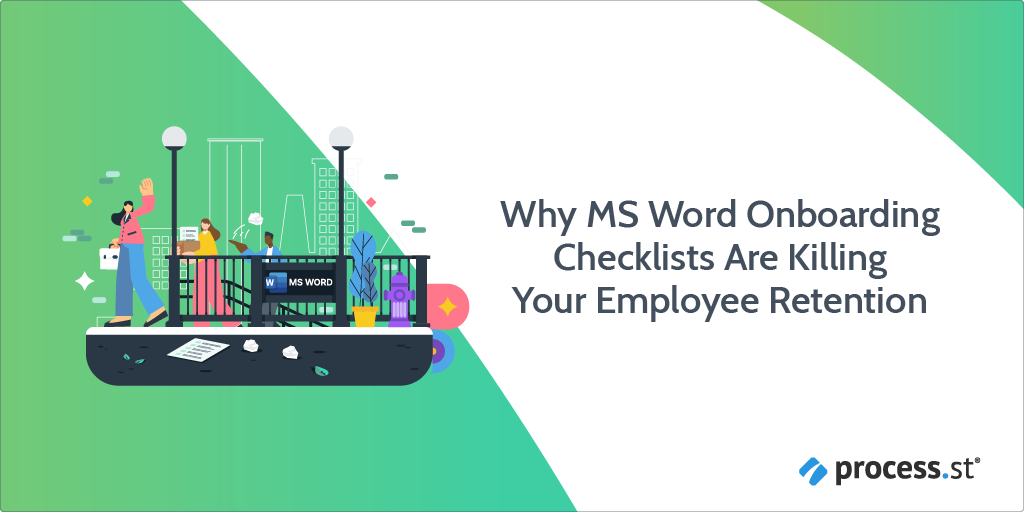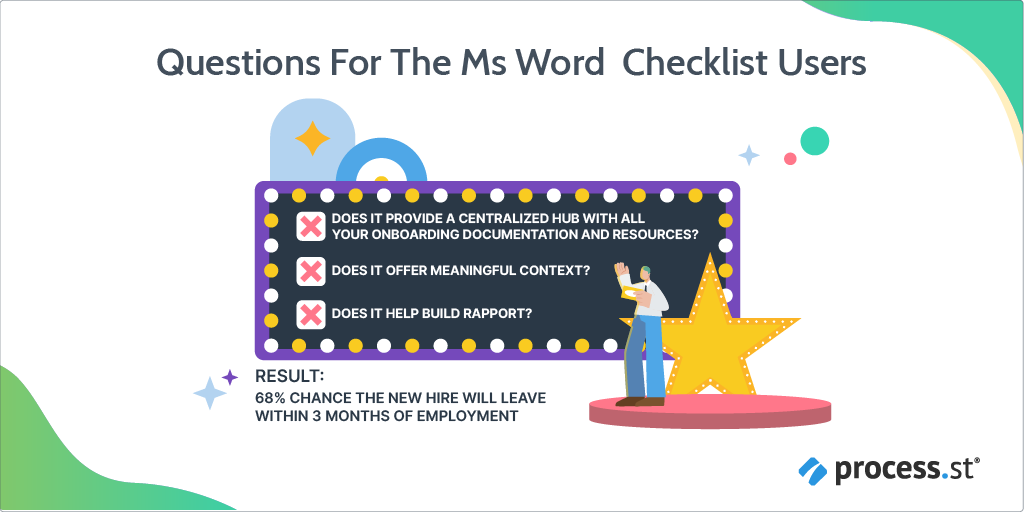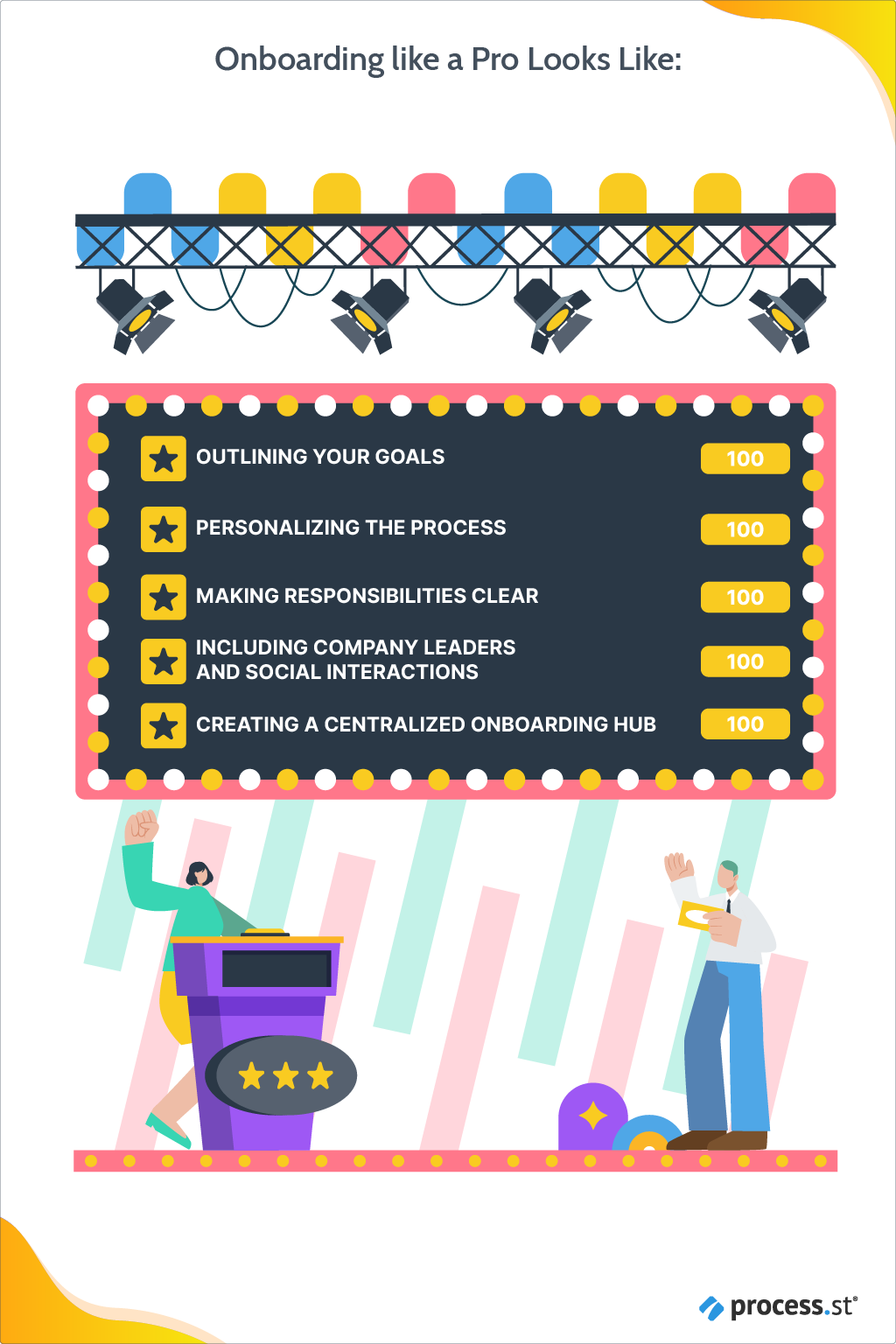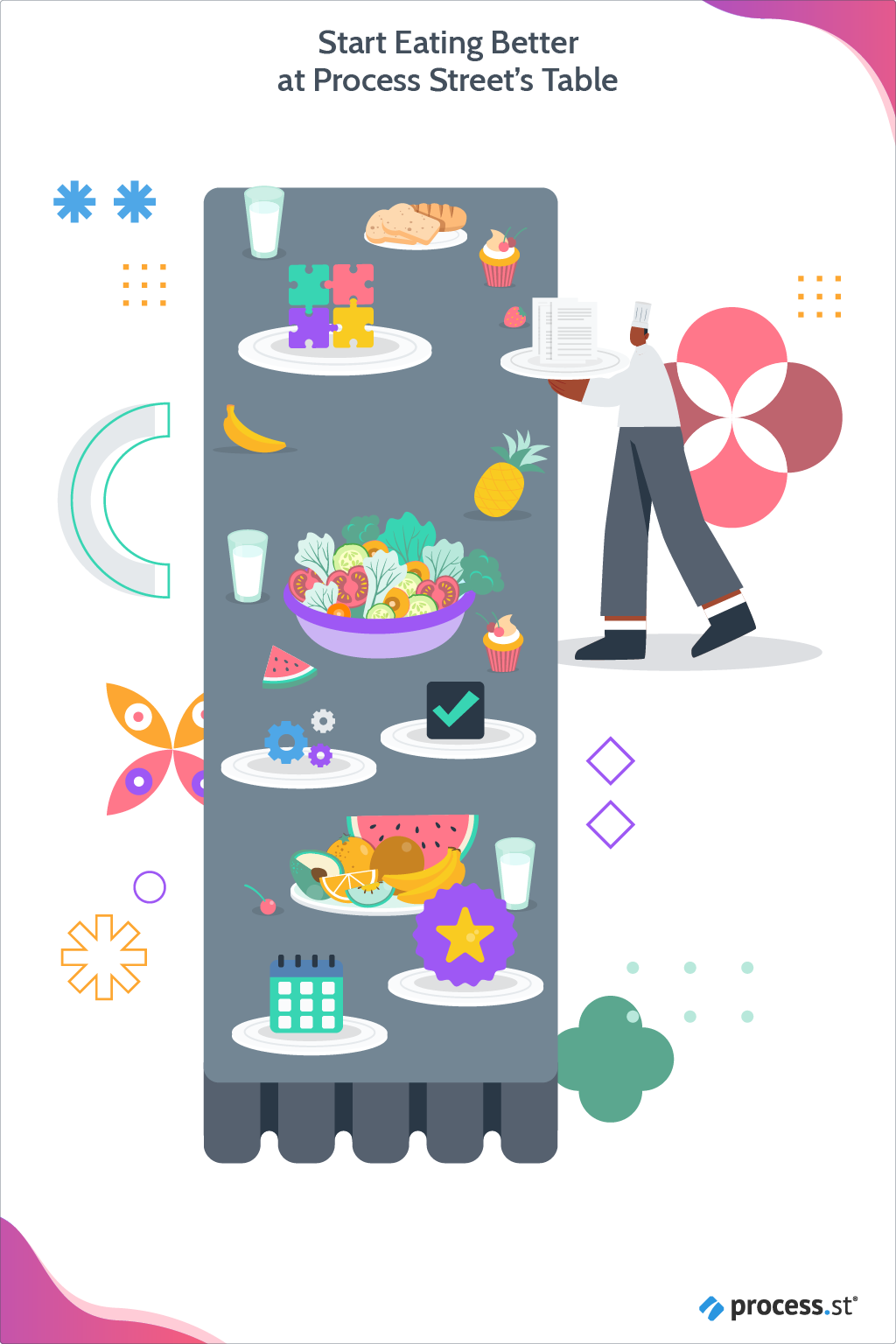 Bamboo HR found that employees are 18 times more likely to feel committed to an employer if they’re given an effective onboarding experience. This is something you certainly want to achieve when onboarding new hires.
Bamboo HR found that employees are 18 times more likely to feel committed to an employer if they’re given an effective onboarding experience. This is something you certainly want to achieve when onboarding new hires.
You might want to head to trusty Microsoft Word to create this effective onboarding experience. After all, it typically is our go-to option for everything else. Want to create a quick newsletter? MS Word. Need a brochure? MS Word. You get the point. But, can Microsoft Word really help you create an effective onboarding experience?
This might come as a shock but your trusty Microsoft Word onboarding template likely has the opposite effect on your new hires. That’s what we’re looking at in today’s Process Street article. But, it’s not all bad. I’m also walking you through the onboarding best practices and how you can implement these with Process Street to optimize your onboarding process and boost your employee retention:
- The cursed Microsoft Word onboarding template
- How do you onboard new hires correctly?
- What does Process Street bring to the table?
- Start eating better at Process Street’s table (& get a free onboarding template goodie bag)
The cursed Microsoft Word onboarding template
I’ve already covered why Microsoft Excel is a terrible idea for employee onboarding. But, here’s the kicker. Microsoft Word is even worse. Unlike Microsoft Excel, it’s not even designed to organize data.
Don’t believe me? When integrating a new hire into your company, you want a template that offers meaningful context, allows you to build a rapport with your new hire, and most importantly, is a centralized hub for all your onboarding processes.
Let’s see if the cursed Microsoft Word onboarding template delivers on this.

Does it provide a hub for all onboarding assets?
Files stack up in no time. This makes keeping track of documents tiring. As you can imagine, your onboarding process can quickly turn into a game of hide and seek (with your missing documents almost always winning) if you don’t create a centralized hub for all your onboarding assets.
Unfortunately, Microsoft Word can’t provide this to you. Yes, you can put data into a Word doc and hand it over to your new hire. But, there isn’t any clear process outlined, nor can you bring anyone else in to make the overall experience more dynamic. It can easily become a chaotic mess without any clear direction of what to do, where to do it, and when it should be done by.
Does it offer meaningful context?
An onboarding experience should be meaningful. It should be structured with a timeline, story, and the necessary context needed for the new hire to feel supported. All Microsoft Word can provide is a tool to document the process. It doesn’t even offer a useful tool to hold necessary data like Microsoft Excel.
Of course, you don’t want some complex system that your new hire can’t navigate. Yet, some things are so simple that they become unsophisticated and don’t actually add any real value. There’s no interactive media, gamification features, or even a clearly structured timeline to provide retention and engagement.
Can you offer adequate human experiences?
Assignments done in Microsoft Word might’ve been exciting in high school. But I can’t imagine onboarding employees with a MS Word template being anything more than a drab. And starting a new position should be anything but boring!
Let’s face it – there’s no ‘human touch’ in a MS Word onboarding template. Your new hires aren’t going to feel welcomed by you including that overused rainbow-colored WordArt (you know which one I’m talking about).
With all that being said, you might be asking “Well, then how can I onboard new hires if not in a Microsoft Word template?” I’ve already got you covered.
Now that you realize that onboarding with a MS Word template is disastrous (I’m not being overdramatic), it’s time I take you to place where the grass is greener (and where you don’t spend half your employment searching for the welcome booklet that’s been around longer than you have).
How do you onboard new hires correctly?
Getting your new employees acquainted with your company by completing onboarding activities isn’t good enough. You need to create an interactive experience where they feel welcomed and supported by the company. That’s how you’re going to retain valuable employees.
This all might sound pretty daunting, but it’s not as bad as it seems. Especially when you take a look at these key features when constructing your onboarding process:

Outline your goals
Each company should create a detailed onboarding plan accompanied with objectives for measuring success.
Your goal in creating this onboarding plan might be to reduce employee churn. Otherwise, you might want to help develop a more comfortable introduction for your new hires.
Goals give you and your new hires direction. Identifying them and implementing them in your onboarding process is going to help you reap success.
Once you’ve planned your onboarding with measurable goals, you can begin constructing and running your onboarding template whenever you hire a new employee.
Personalization is key
It’s vital that your onboarding experience remains consistent. That doesn’t mean that you can’t personalize the experience for each of your new hires. Personalization is great – and it’s one of the keys to onboarding success.
An example might be providing a company t-shirt with their name on it or a personalized mouse pad. Personalization can even be including a specific task in the onboarding process that’s related to their department.
Make responsibilities clear
The last thing any new hire wants is to have to play the guessing game. You don’t want them being unsure of what’s expected of them. That’s why it’s important to make their responsibilities clear from the moment they walk into their new role.
Include company leaders and social introductions
Leadership plays a critical role in new hire onboarding. New employees typically feel valued when leadership members are involved in their onboarding experience. I surely would feel more engaged in the onboarding process if managers are active participants in the experience, don’t you?
It’s not just company leaders that should be included. Co-workers are just as important. HR managers should pay careful attention to social interactions when it comes time to onboard a new employee. As a new hire, you’re more likely to assimilate into the culture and feel more welcome if you have a team of co-workers involved in the transition as well.
Create a centralized onboarding hub
You want to create an onboarding process that’s interconnected with all your onboarding assets and documentation for easy access. This way, you don’t need to spend half your working day searching for various onboarding resources – it’s all in one place.
Of course, you want all your employees to have access to this onboarding hub. Digital platforms work best when it comes to creating a centralized onboarding hub. This onboarding software is designed to anticipate the needs of your new employees and help you automate the process so you spend more time creating a valuable onboarding experience.
What does Process Street bring to the table?
So, you’ve read the best onboarding practices and have hit a wall. You’re possibly thinking, “Well, thanks Grace but this just seems like more work for me to do.” I promise my goal wasn’t to give you an existential onboarding crisis. I wouldn’t give you a list of best practices without providing you with a solution, so here it is:
Pages for planning
Before creating an effective onboarding process, you need to have a well-structured plan. From detailing your goals to highlighting the various onboarding activities you need your new hires to complete, Pages is the right place.
Pages works as an internal process documentation library that lives alongside your workflows to help you better understand what process you intend to construct. This helps you structure an onboarding process that gives your new hires direction while igniting engagement.
We make it personal
You want to create a consistent onboarding process, but you also want to offer some personal touches for each new hire. Process Street can help you with that. Features like variables empower you to add personal data to form fields.
For example, you might want to address your new hire by name in an email widget but still have a uniform structure. Easy – all you need to do is add the variable detailing their name into this email widget. You can add all kinds of personal information like their start date. Or Conditional Logic can be used to show tasks and reading lists specific to the new hire’s relevant department.
Everything is crystal clear
You want transparency when it comes to performing company processes. Process Street gives exactly that to you. With the useful progress tracker, you can see what workflows are being worked on, when the last activity was completed, and who did it.
With such transparency, you also offer a clear direction for your new hire to follow. They know what they need to do and how to do it – already one step closing to offer the best onboarding experience!
Bring in whoever you want
Task assignments make it easier to see who is responsible for what. Tasks can be set to create social interactions and meetings with leadership. You can also assign whoever you want to these tasks, so the onboarding process isn’t just between the HR manager and the new hire. This helps enhance engagement and creates a more interactive and rich onboarding experience.
Everything’s in one place
With Pages living alongside your workflows, all of your onboarding assets can be found in one place. No longer do you need to worry about where that pesky reading list or building safety procedures are. Pages is also great for storing and sharing introductory documents like your employee benefits information and employee handbook.
But that isn’t all. Process Street has many integrations, so you can use other digital platforms like Slack to enhance communication amongst your employees – we all know how vital communication is for a company, especially during onboarding.
Having a centralized onboarding hub, like Process Street, also gives you access to automations. This is exactly what you want when onboarding new hires. Many tasks are recurring and don’t require complex skills to complete. These can easily be automated, saving you time to spend rather building a rapport with your new hire and enriching their experience.
Start eating better at Process Street’s table (& get a free onboarding template goodie bag)
 Helping you plan your onboarding experience, bringing in whoever you want, providing transparency, and creating a centralized onboarding hub are elements that are vital to onboarding success. And these are the very things MS Word onboarding templates can’t provide.
Helping you plan your onboarding experience, bringing in whoever you want, providing transparency, and creating a centralized onboarding hub are elements that are vital to onboarding success. And these are the very things MS Word onboarding templates can’t provide.
That doesn’t mean all hope is lost. There are far more advanced tools out there now that are designed to specifically help with onboarding. Process Street is one of these.
Nonetheless, I get that the responsibility of creating an onboarding template that embodies all of these qualities can be daunting and time-consuming in itself. I’ve taken the liberty of creating an onboarding template for you already.
Click here to get your free Process Street onboarding workflow.
It’s designed to help you reap onboarding success immediately. You can add it to your library now, run it whenever you onboard a new hire, and edit it to fit your specific needs.
What’s the worst onboarding experience you’ve had? Let us know in the comments below.







Grace Donaldson
Grace is a content writer with a thirst for knowledge and coffee. You'll find her reading in a small café or singing at a rundown jazz bar when she's not overconsuming coffee or compartmentalizing her thoughts into a blog post.